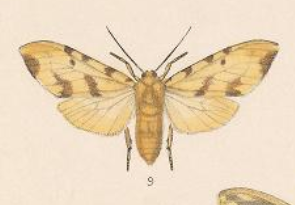
Lophocampa is a genus of moths in the family Erebidae. The genus was erected by Thaddeus William Harris in 1841. It contains around 75 species.

Lophocampa ingens is a moth of the family Erebidae. It was described by Henry Edwards in 1881. It is found in the southern Rocky Mountains and in Mexico.

Lophocampa montana is a moth of the family Erebidae. It was described by William Schaus in 1911. It is known from Poás Volcano in Costa Rica.

Lophocampa affinis is a moth of the family Erebidae. It was described by Walter Rothschild in 1909. It is found in Mexico.

Lophocampa andensis is a moth in the family Erebidae. It was described by Schaus in 1896. It is found in Colombia.

Lophocampa albipennis is a moth of the family Erebidae. It was described by George Hampson in 1904. It is found on the Bahamas.

Lophocampa annulosa, the Santa Ana tussock moth, is a moth of the family Erebidae. It was described by Francis Walker in 1855. It is found in southern Texas, southern Arizona, Mexico, Costa Rica, Ecuador, Venezuela, Peru, Suriname, Brazil, Argentina and Trinidad.

Lophocampa atrimaculata is a moth of the family Erebidae. It was described by George Hampson in 1901. It is found in Costa Rica, Brazil, Bolivia and Peru.

Lophocampa bicolor is a moth of the family Erebidae. It was described by Francis Walker in 1855. It is found in Mexico and Big Bend National Park, Texas.

Lophocampa catenulata is a moth of the family Erebidae. It was described by Jacob Hübner in 1812. It is found on Cuba and in Mexico, Costa Rica, Guatemala, Panama, Venezuela, Suriname, French Guiana, Brazil, Peru and Argentina.

Lophocampa citrina is a moth of the family Erebidae. It was described by Jan Sepp in 1843. It is found in Mexico, Honduras, Panama, French Guiana, Brazil, Venezuela and the Amazon region.
Lophocampa dinora is a moth of the family Erebidae. It was described by William Schaus in 1924. It is found in Argentina and Bolivia.

Lophocampa endolobata is a moth of the family Erebidae. It was described by George Hampson in 1901. It is found in Brazil.

Lophocampa grotei is a moth of the family Erebidae. It was described by William Schaus in 1904. It is found on Cuba.
Lophocampa indistincta is a moth of the family Erebidae. It was described by William Barnes and James Halliday McDunnough in 1910. It is found in California, where it is only found on the Channel Islands.

Lophocampa labaca is a moth of the family Erebidae. It was described by Herbert Druce in 1890. It is found in Jalisco, Mexico.

Lophocampa laroipa is a moth of the family Erebidae. It was described by Herbert Druce in 1893. It is found in Costa Rica, Guatemala, Ecuador and Brazil.

Lophocampa luxa is a moth of the subfamily Arctiinae. It was described by Augustus Radcliffe Grote in 1866. It is found on Cuba.

Lophocampa margona is a moth of the family Erebidae. It was described by William Schaus in 1896. It is found in Mexico.
Lophocampa niveigutta is a moth of the family Erebidae. It was described by Francis Walker in 1856. It is found in Brazil and Colombia.

















